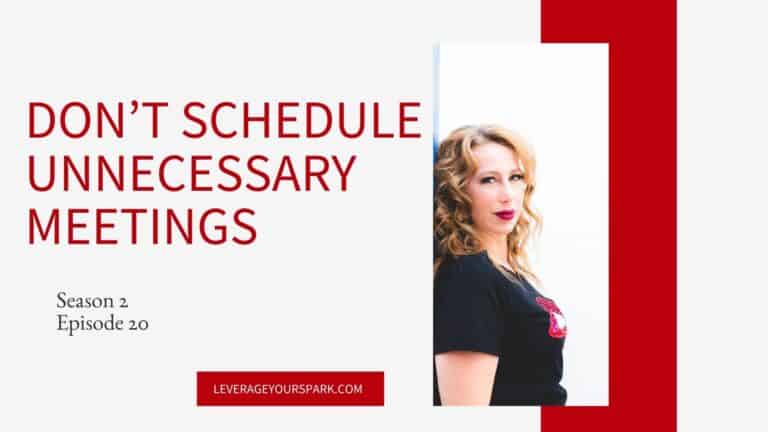Don’t Schedule Unnecessary Meetings; Do This Instead

Unnecessary meetings and excessive emails are personally offensive to me because efficiency and effectiveness are two of my top values. You can avoid pointless emails and meetings when you do this instead. Your colleagues will thank you.
Listen to Season 2: Episode 20
Unnecessary Meetings: The Bane of My Existence
One of the reasons I have to have my own company at this point in life is because ineffective and inefficient systems make me crazy. And nothing’s a bigger offender than unnecessary meetings.
We all know that no actual work gets done in meetings. So how is it that people caught up in meetings all day are expected to be able to do their work? They can’t. And even if you’re like our company and run a small team, we still need effective communication. But meetings are rarely the best choice. What to do instead? Oh, you know I can’t wait to tell you.
Meeting Alternative #1: Screencasting
What’s fabulous about technology is it has given us a plethora of wonderful options that, when properly used, can replace a lengthy email or meeting. These options are voice and screen recordings. Let’s just be clear: Not all voice and screen recording tools are created equal. There are a lot of small things that go into making a tool extremely effective. The tool we use when instead of scheduling a meeting when we need to assign a task, document a process, or give feedback on something, is Loom, and it is a screencasting tool.
Now, before you’re like, “Oh, I’ve got one of those,” here’s what makes Loom different. For the person sending the recording, it’s as easy as click, talk while doing things on your screen, click again, and paste a link.
Yes, literally in three clicks you can send someone a video of your screen; it can even have your face on it. The reason this is so powerful is because it gives context. And it’s easy. The link goes in your clipboard as soon as you stop recording.
Why Loom?
Of course, there are all kinds of screencasting tools, and they’re great at capturing the screens. But when you’ve captured your video, you then have to upload it or save it somewhere. And then you have to share it or get the link. Just no.
Loom is click, click, paste. Seriously that easy. And that is what makes it so simple to communicate when a document has been sent for feedback, or when I need to give more context, or when something hasn’t gone quite right. I even use Loom videos for support tickets. No need to try to type out what’s happening; I just show it in a Loom and paste a link in the ticket.
In our day-to-day work, if I’ve just had a meeting with a client where we discussed something that needs to happen, and as a result, I’m assigning a task to the team based on the conversation, I will use Loom to give context to the task.
Many times, when a task is assigned to an external agency or vendor, if they have a question or if something isn’t clear, or if they got into the task and it was different than expected, they will send a Loom back that shows exactly what’s going on for them. This eliminates trying to find a time to meet with busy schedules and different time zones. It also eliminates lengthy emails. Don’t even get me started on novels masquerading as emails.
Meeting Alternative #2: Voice Memos
The other tool that we use is voice memos. Two really great apps for this are Voxer, which is an app on the phone where you can send voice memos back and forth, or Otter, an app where you can record a voice memo and then get a recording and transcript and share a link with someone else. These are useful for situations when you need to communicate with inflection or context that doesn’t necessarily involve a screen or quick volleys back and forth. Occasionally, we’ll be troubleshooting things and can’t quite sync up for a quick meeting. Either I’m out doing something, or my project manager is not able to get on the phone, so instead we exchange Voxers. With that, I can say, here’s what I’ve done or what I’m seeing, and then five minutes later, she can come back and respond.
These are better tools than emails or texts because we can do them quickly, we’re not trying to censor ourselves, and they also have the context of inflection with our voices.
Skip Your Unnecessary Meetings
Next time, before you schedule a meeting or find yourself creating a manuscript in an email, take a moment and try out Loom, Voxer, or Otter; that is, use a screencast or a voice memo because I guarantee this will be easier on you and easier for the recipient. When they receive the Loom, not only can they pause it to process or act, they can also watch it more quickly, or multiple times. Ultimately, it likely will take less of their time than a meeting because you can put all your thoughts together, they can absorb your thoughts, and then they can come back with a response. Stop scheduling unnecessary meetings and start using the technology available.
What’s Up Next
Next time on Leverage Your Spark, it’s the beginning of the end…of the season. There are five episodes left, and we’ll get into what no one wants to talk about when working with external agencies or experts: how to handle the end of the relationship.
Wish you had an efficiency expert in your business? No need to wish; let’s talk.

